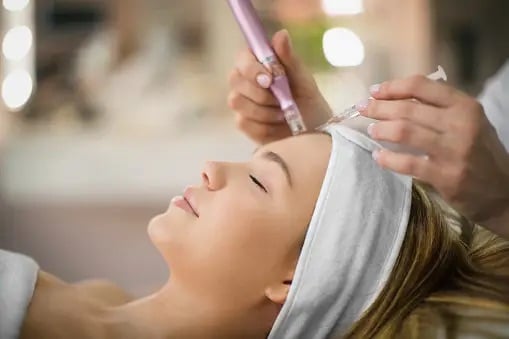Micro needling
Lets discuss micro needling. What it is, how long it lasts, what is involves etc...
Zoey Prescott (RGN, INP)
3/17/20242 min read


My post content
What is Micro needling?
Micro needling is a popular cosmetic procedure that involves the use of small needles to puncture the skin and encourage the production of collagen and elastin.
This process has numerous benefits for the skin, including making it smoother, firmer, and more toned. Typically performed on the face, micro needling can effectively treat various skin conditions like scars, wrinkles, and large pores.
It is also referred to as collagen induction therapy due to its ability to stimulate the production of collagen. This innovative procedure has gained widespread acclaim for its ability to improve the overall appearance and texture of the skin, offering individuals a non-invasive solution to achieve a more youthful and radiant complexion.
How often should i have the treatments?
Micro needling treatment is a minimally invasive procedure that involves using tiny needles to create controlled micro-injuries on the skin. These micro-injuries stimulate the production of collagen and elastin, leading to improved skin texture and appearance. The frequency of micro needling treatments depends on individual factors such as skin condition and desired results.
In general, it is recommended to have micro needling done every 4-6 weeks to allow the skin enough time to heal and regenerate. However, it is best to consult with a skincare professional who can assess your specific needs and provide personalized recommendations.
Remember to follow a proper skincare routine and protect your skin from excessive sun exposure for optimum results, always use SPF 50 in your daily skincare routine.
What's the difference in chemical peel and micro needling?
Chemical peel and micro needling are both popular skin treatments, but they differ in their approach and results.
Chemical peels are a form pf chemical exfoliation, which causes the skin to purge the older skin cells and stimulates new cell growth of the skin, they leave your skin feeling soft and refreshed and noticeably glowing instantly. A chemical peel involves applying a chemical solution to the skin. It is effective in treating acne scars, sun damage, and uneven skin tone, however does not stimulate collagen production to the underneath layers.
On the other hand, micro needling uses tiny needles to create micro-injuries in the skin, a chemical formulation of hyaluronic acid, minerals and vitamins are put onto the skin and the device then causes micro punctures to the skin allowing the chemical to penetrate and stimulate the outer dermis, it also stimulates collagen production, which helps reduce fine lines, whilst enhancing skin rejuvenation. It targets fine lines, wrinkles, and improves skin texture.
With micro needling there usually is a little shedding of the skin within the first week post treatment and usually lasts approx. 1 week.
The amount of treatments required is dependent on the noticeable changes you require to your skin at intervals of 4-6 weeks.
It's essential to consult with a skincare professional to determine which treatment suits your specific needs and goals.
How long does the procedure take?
The process for carrying out micro needling takes approx. 45 minutes.
Firstly, the skin on the face is cleansed and oils removed and the skin dried, next a layer of numbing cream is placed onto the skin for your comfort during the procedure. This is allowed to work for 15 minutes.
Next a solution of hyaluronic acid, vitamins and minerals is put onto the skin to aid the micro needling device to glide without dragging the skin, there should be minimal discomfort due to the numbing cream.
Following the treatment, a soothing mask of hyaluronic acid, vitamins and minerals is placed onto the skin for approx. 10 minutes to help cool and soothe the skin.
Make up and usual creams can be used in a minimum of 6 hours post treatment.
